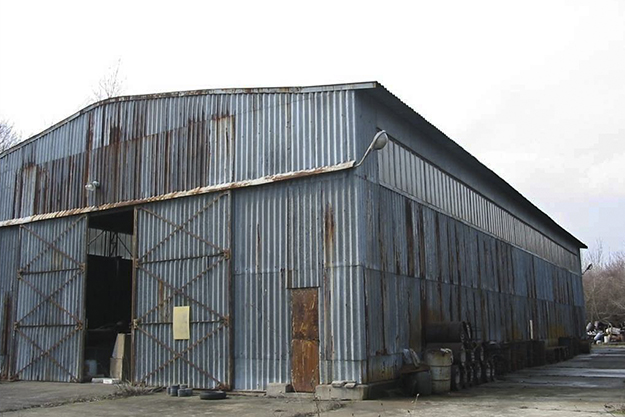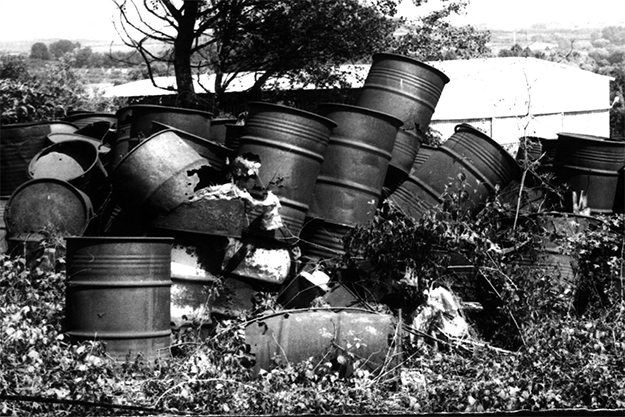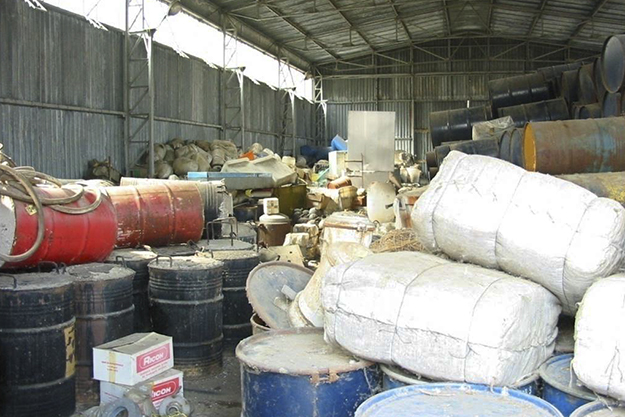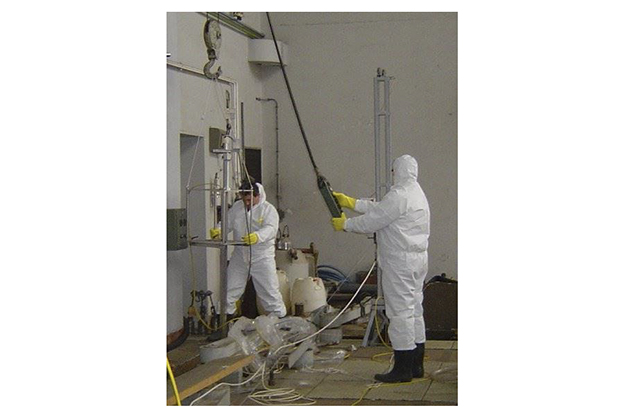Walking around the bustling streets of Belgrade or Niš’s public squares, few residents take the time to look up above the natural eye line as they go about their daily business.
If they did, they probably wouldn’t pay much attention to the little metal rods sticking out the top of the towering socialist era apartment blocks or the decades old industrial buildings. Designed to conduct potential lightning strikes to the ground, they are generally out of sight, out of mind.
However, many of these unremarkable bits of metal, which were commonly installed throughout Yugoslavia, contain a potentially hazardous radioactive core.
Installed in the 1960s and 1970s, lightning rods with radioactive centers were thought to provide a wider coverage of potentially vulnerable buildings, but began being replaced with electrical rods in Yugoslavia and worldwide in the 1980s, and for good reason. Experts have determined that these lightning rods do more potential harm than good, due to the risk of exposing citizens to radiation.
Serbia amended its Law on Ionizing Radiation Protection and Nuclear Safety in 2012, and the removal of all remaining radioactive rods was foreseen by May 2015. However, insufficient funds led to hundreds of these rods being left in situ.
According to the records of the Serbian Radiation Protection and Nuclear Safety Agency — the government agency charged with regulating and monitoring radiation and nuclear activities — 638* residential and commercial buildings throughout the country still possess radioactive lightning rods.
“Depending on the location, the removal of one radioactive lightning rod and the installment of a new one costs between 2,500 and 3,000 euros,” says Slađan Velinov, director of the Agency.
Beyond the issue of removing the remaining rods is that of properly disposing of them. Currently, upon their removal, the radioactive lightning rods are stored some 12 kilometers away from downtown Belgrade on the property of the Vinča Institute of Nuclear Science, a multidisciplinary scientific research institute that is part of the University of Belgrade.
A concrete path through green trees connects almost a dozen Vinča complex buildings; the most distant are a number of large hangars, supervised by security personnel. These hangars contain radioactive and nuclear waste, and are not advisable to approach due to (relatively low) radiation.
Besides housing the radioactive rods, the site is already a dumping ground for other nuclear waste, including stocks of radium that were sprayed with concrete in 1999 as they constituted a potential source of danger; a barrel with shells and soil affected by depleted uranium collected during the NATO bombing of Serbia; radium needles and tubes used for cervical cancer treatment until labeled dangerous in the 1970s; waste from the shutdown of Serbia’s nuclear reactor (from a time when Yugoslavia attempted to develop its own nuclear program) in the 1980s; and other waste with ambiguous composition.

Hangars inside the Vinča Institute contain nuclear waste, the composition of some of which is unknown. Photo: Private archive of Dr. Ilija Plećaš.
In a written response to K2.0, Bojan Radak, assistant director at the Vinča Institute, said that security and safety measures at the Vinča site where the hangars are located are implemented “in full capacity.”
But a few years ago, the International Atomic Energy Agency (IAEA) made an assessment that one of the primary issues in safely managing this waste was the fact that the composition of some of it remained unknown. Therefore, IAEA concluded, the Vinča Institute could not be a permanent landfill for radioactive waste, “but a temporary station through which waste will pass.”
Despite the fact that the hangars are meant for temporary conditions, some of the waste at the landfill has remained there for nearly 60 years, in the hands of the Serbian Nuclear Facilities Public Enterprise (JP NOS), which is now responsible for taking care of it.
The quest for a permanent solution
Since the end of World War II, the Vinča Institute of Nuclear Science has received radioactive and nuclear waste from throughout the Balkans. Dr. Ilija Plećaš, a member of JP NOS’s board of directors and the former director of the Vinča Institute, remembers a time when barrels with waste were scattered in the backyard of Vinča.
“It stood there until 1982. People walked through that area — it was terrible,” Plećaš says, adding that the first temporary solution was presented in 1967 in the form of Hangar 1, where the barrels were stored. “Hangar 1 is in bad shape. This, as well as the waste from Hangar 2 [built in 1981] should be repackaged and stored in a safe place.”

A photo from 1982 showing barrels in which nuclear waste was stored within the Vinča Institute. The space and method of storage have changed little in the three and a half decades since. Photo: Private archive of Dr. Ilija Plećaš.
According to available data, the waste found in these two hangars was collected as early as 1948.
Plećaš believes that a permanent solution to the radioactive waste storage issue would include the selection of a special location, at a safe distance from populated areas, where the previously processed radioactive and nuclear waste could be stored for a period of 300-500 years, which is the amount of time necessary for radioactive elements to decay.
Prior to permanent storage, waste should be processed and repackaged in a dedicated processing plant.
In the second half of December 2018, by means of urgent procedure and without a public debate, Serbia adopted the new Law on Radiation and Nuclear Safety.
According to the old 2009 law, Serbia was obliged to solve the issue of radioactive waste disposal by February 2019; the law foresaw the construction of a permanent landfill site, but the issue hasn’t been a priority of any government to date, even though warnings have been issued by experts.
The construction of a permanent landfill for radioactive waste is not even mentioned in the new law.
Experts believe that by adopting the new law, Serbia has eliminated the possibility of a permanent solution for disposing of radioactive and nuclear waste, and now it seems that a potential solution is further away than it was 10 years ago.
Slađan Velinov says that the only reason for an urgent adoption of the new law lies in the deadlines for implementing reforms established by the EU as part of Serbia’s accession process.
Instead of enabling a quick solution to the problem, experts are concerned that by adopting the new law, Serbia has liberalized the conditions for importing materials with natural radioactivity, such as granite, marble and phosphorus.
The new law contains articles regulating the terms of constructing nuclear plants, which has again opened up the possibility for building nuclear plants, something on which in 1974 the Socialist Federal Republic of Yugoslavia imposed a moratorium, which was inherited by Serbia. This kind of development would mean potentially more radioactive waste.
Also, the new law foresees support in the process of the removal of remaining radioactive lightning rods. According to the old law, expenses for removing lightning rods were borne by building owners, or the community of tenants in residential buildings. The new law foresees that the cost of removing lightning rods falls upon local government budgets.
A total of three organizations in Serbia have the authorization to remove lightning rods — two are part of the Vinča Institute of Nuclear Science, and the third is a private one. In the second half of November 2018, Velinov announced the allocation of 11.5 million Serbian dinars (about 97,000 euros) from the budget of the Serbian Radiation Protection and Nuclear Safety Agency for removing the so called radioactive lightning rods.
“We expect it to increase the efficiency of removing lightning rods, especially on residential buildings,” Velinov says, emphasizing that, sensitive to the situation on the ground, the Agency’s goal is to help citizens accelerate this process. “With the funds redirected from our budget, 35-40 [of the remaining 638] lightning rods can be removed.”
Accidents and consequences
From the 1950s through the early 1970s, the Vinča Institute had an operational nuclear reactor meant for scientific research, while the world sibilated about Yugoslavia developing a nuclear program.
The reactor suffered a malfunction in 1958, with a number of Yugoslav physicists suffering radiation exposure — as a result they went on to become the first people in the world to undergo bone marrow transplantation from strangers. The reactor was shut down in practise in 1984, but it was only in 2002 that the government in place at the time took the formal decision to decommission it.
The radioactive fuel used for its work was stored in four basins, also found on the Vinča Institute site. But in 2010, the fuel leaked from the four basins in which it had been kept.
“What happened is that the container holding the fuel corroded,” says Dr. Uranija Kozmidis, who was state secretary of the Ministry of Science in 2007-08 and today is a professor at the Faculty of Technical Sciences in Novi Sad.
After the accident, it was determined that there were no appropriate means for storing the fuel in Serbia, and it was deployed later that year to Russia’s Nuclear Enterprise “Majak,” near Chelyabinsk, in the Ural Mountains. Before transportation of the fuel to Russia was able to take place, it first required urgent reprocessing. It was at this point that a temporary plant for waste processing was established in one of the facilities at the Vinča site.
Kozmidis states that the water, a protective layer for fuel, which absorbed the radioactivity during the “leak,” was never cleaned from the basin.
In a standard chain of events, she said, processed radioactive and nuclear waste is kept in a secure hangar for a period of two to three years for monitoring, before ultimately being buried in a permanent landfill site.

The interior of the hangars in which nuclear waste is stored. Photo: Private archive of Dr. Ilija Plećaš.
“The plan for processing is the key link in a string of events that would lead to a permanent and secure solution,” Kozmidis says, adding that plans for building a processing plant and a permanent landfill site existed, but were never fully implemented.
Kozmidis was state secretary during the time of the Vojislav Koštunica government. As part of the then Ministry of Science, a commission was established in 2007 that was supposed to deal with solving the issue of permanent disposal of nuclear and radioactive waste. Due to unsatisfactory conditions in the old hangar, the Commission prioritized the construction of a new one.
“During my term, Hangar 3 was built, in line with European standards. This hangar is very secure,” Kozmidis says.Barrels with unprocessed waste are now stored in the relatively recently built Hangar 3, which is the only hangar that experts agree is in good shape. Still, Kozmidis questions the storing of such waste without a permanent solution. “The only advantage of Hangar 3 is that it is in good shape, and it is therefore somewhat safer than the remaining two,” she notes.
In March 2008, less than a full year after the May 2007 formation of his second government, Koštunica resigned and asked for the dissolution of the Assembly, calling for early parliamentary elections. As collateral damage of the political turmoil and the subsequent transfer of the domain of science and technological development to the Ministry of Education, the Commission ceased to exist. A new one has yet to be established.
A topic that isn’t discussed
Even though the construction project for the processing plant was partially developed in 2008, it was never completed. The temporary processing plant, which the repackaged fuel “leaked” into in 2010, is not used today. Director Velinov explains that the facility is not functional since it doesn’t possess the necessary licenses, nor a construction permit.
Kozmidis says that Hangar Zero — the uranium sprayed with concrete for safety reasons during the 1999 NATO bombing — also needs to be cleaned, although adds that radium under the concrete coating is not emitting radioactivity for now. “Nothing else is known about this,” she says. “Nobody talks about this, and neither will I.”
She adds that radioactive waste is not 100 percent predictable. “The fact that there are currently no emissions of radioactivity does not mean that there won’t be any someday,” Kozmidis emphasizes. “This is why it is necessary to repackage all this waste and permanently store it.”
Dr. Ilija Plećaš from JP NOS also insists that building a permanent landfill site is essential to prevent potential accidents or the “possible misuse of radioactive waste,” as well as for the sake of general security. In 2018, he published a book titled, “Radioactive Waste: What to Do With It,” in an attempt to draw the attention of the government toward this issue.
Plećaš emphasizes that the authorities are now largely uninterested in solving this issue, which he says “may not be urgent, but is very important.”
“Vinča should be a serious science institute, not turned into a graveyard,” he says. “Nowhere in the world is science only a few hundred meters away from a cemetery.”
Kozmidis points out that there is no place for panic, but that actions should be taken as soon as possible that would lead to the permanent storage of radioactive and nuclear waste. “Radioactive waste gets out of hand if it isn’t adequately protected, and may become a source of panic,” she emphasizes.
Slađan Velinov agrees: “A landfill is needed, and I hope that it will be built in the next 20 or so years,” he says.

Experts warn that it is necessary to quickly find a safe solution for disposing of the radioactive waste that is currently stored in Vinča. Photo: Private archive of Dr. Ilija Plećaš.
Dr. Bojan Radak from the Vinča Institute, believes that Vinča and JP NOS have a sufficient number of experts who can carry out the construction of “any kind of landfill for radioactive material, even in other countries, if necessary.”
However, there has been no sign of any initiative of this kind. “I have been waiting for this for 20 years now,” Dr. Ilija Plećaš says. “I have spoken to 13 ministers and they have all told me: ‘This is important, but let’s not do it during my mandate.’”
With the way things currently stand, unprocessed radioactive and nuclear waste will until further notice be kept in the hangars on the Vinča site, in the immediate vicinity of the Serbian capital. Furthermore, waste will continue to be delivered to Vinča, which remains the only place that somewhat secure conditions for storing waste exist.K
Feature image: Besnik Bajrami / K2.0.
* Editor’s note: This figure has been corrected after publishing. In this original version of this article, it was written that 706 buildings in Serbia still have radioactive lightning rods.






Nice article! The pictures really show how things are handled in reality. Too many problems for one country I guess Regards, Nikola